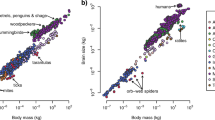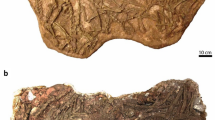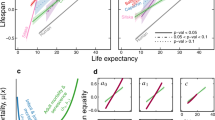Abstract
THE quantitative study of relative growth and the proportion of parts has in recent years made considerable progress, and is now beginning to find widespread application in such diverse fields as systematics, embryology, genetics and palæontology, as well as in growth-studies proper. Unfortunately, serious diversities of terminology and notation have sprung up1,2,3,4,6,6. We therefore wish to propose the following agreed terminology to avoid confusion.
This is a preview of subscription content, access via your institution
Access options
Subscribe to this journal
Receive 51 print issues and online access
$199.00 per year
only $3.90 per issue
Buy this article
- Purchase on Springer Link
- Instant access to full article PDF
Prices may be subject to local taxes which are calculated during checkout
Similar content being viewed by others
References
J. S. Huxley, ” Problems of Eelative Growth”. Methuen, London (1932).
G. Teissier, 1934. ” Dysharmonies et discontinuités dans la Croissance”. Act. Sci. et Industr., No. 95. (Exposés de Biometrie, 1) (1934). Hermann, Paris.
B. Nomura . ” An Application of a=kbx in expressing the Growth Relation in Molluscan Shells”. Sci. Rep. Tohoku Imp. Univ. (4), 2, 53 (1926).
F. W. Weymouth and D. C. G. Maekay, ” Relative Growth in the Paciflc Edible Crab, Cancer magister”. Proc. Soc. Exp. Biol. Med., 81, 113 (1934).
W. J. Crozier and E. V. Enzmann, ” On the Relation between litter-Size, Birth-Weight, and Kate of Growth in Mice”. J. Gen. Physiol, 19, 249 (1935).
M. Raja, ” Sull'accrescimento postembrionale del Loligo vulgaris”. Boll. Zool. Torino, 5, 1 (1934).
C. Champy, ” Sexualité et Hormones”. G. Doin, Paris (1924).
A. Pezard, ” Le conditionnement physiologique des caractères sexuels secondaires chez les Oiseaux”. Bull. Biol. Fr. et Belg., 52, 1 (1918).
R. Leuckart, 1876. ” Die Menschlichen Parasiten” (Bd. 2), Leipzig (1876).
J. Meisenheimer, ” Geschlecht und Geschlechter”. Jena (1921).
A. Weismann, ” Beitr. zu. Naturgeschichte der Daphnoiden”, Leipzig (1878).
H. F. Osborn, ” The Origin of Species”. (2) ” Distinctions between Rectigradations and Allometrons”. Proc. Nat. Ac. Sci., 11, 749 (1925).
A. H. Hersh, ” Evolutionary Eelative Growth in the Titanotheres”. Amer. Nat., 68, 537 (1934).
R. C. Robb, ” Two Modes of Evolution in the Horse”. Proc. Sixth Internat. Congr. Genetics, 2, 166 (1932).
Author information
Authors and Affiliations
Rights and permissions
About this article
Cite this article
HUXLEY, J., TEISSIER, G. Terminology of Relative Growth. Nature 137, 780–781 (1936). https://doi.org/10.1038/137780b0
Issue Date:
DOI: https://doi.org/10.1038/137780b0
This article is cited by
-
Multiscale insights into postnatal aortic development
Biomechanics and Modeling in Mechanobiology (2023)
-
Ontogenetic drivers of morphological evolution in monitor lizards and allies (Squamata: Paleoanguimorpha), a clade with extreme body size disparity
BMC Ecology and Evolution (2022)
-
Incongruences between morphology and molecular phylogeny provide an insight into the diversification of the Crocidura poensis species complex
Scientific Reports (2022)
-
Shell Morphology, Morphometric Relationships and Relative Growth of Three Topshell Species (Gastropoda: Trochidae) from the Algarve Coast (Southern Portugal)
Thalassas: An International Journal of Marine Sciences (2022)
-
Size variation, allometry and mating success in Aotearoa|New Zealand kelp flies (Coelopidae)
Evolutionary Ecology (2022)
Comments
By submitting a comment you agree to abide by our Terms and Community Guidelines. If you find something abusive or that does not comply with our terms or guidelines please flag it as inappropriate.



